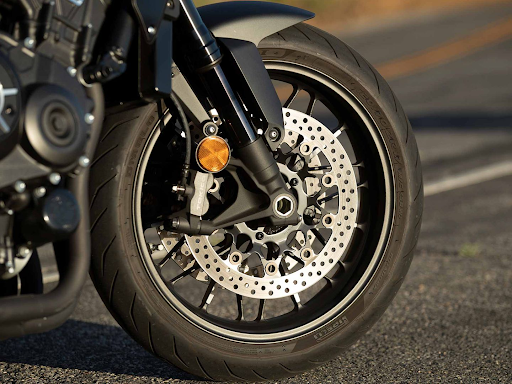Review 2024 Honda CB1000R
Review of the Honda CB1000R Black Edition for 2024
Is this an evil knight's chariot?
The CB1000R Black Edition from Honda is a practical liter-class streetfighter. The wild excesses of a KTM 1290 Super Duke R or a Ducati Streetfighter V4 are not for Honda. No, Honda appears to be claiming with this bike that you don't need all of the horsepower of a liter-class racer. You'll need a powerful, well-balanced performance, as well as nice appearance and a reasonable pricing. Then it goes on to do just that.
The Black Edition is the only version of the CB1000R available in the United States, a midnight special featuring polished aluminum accents on the wheels, engine, and footpeg brackets, as well as a stainless exhaust.
The CBR1000R's powertrain is an upgraded and retuned version of the one that debuted in the 2004 CBR1000RR. It's a four-cylinder screamer with a short stroke (75mm bore by 56.5mm stroke) that's been modified for torque and comes with the newest two-way slipper clutch for a light pull.
The bike takes off quickly thanks to the short gearing and 1,000cc engine, with the front tire simply skimming the ground. Similarly, measured performance is good, but not outstanding for a literbike: The CB sprints the quarter-mile in 11.1 seconds and reaches a top speed of 128 mph.
The time it takes to accelerate from a standstill to 60 mph is under 3.3 seconds, which is both wheelie- and power-limited. That quarter-mile time and trap speed are a touch faster and faster than a Yamaha MT-09 SP, but a little slower and slower than the liter-class streetfighter end of the range.
The riding posture and ergonomics, though, reveal more about the bike's personality than the detuned Superbike engine. Your legs aren't tightly curled since the pegs are planted precisely beneath you, and the reach from the 32.8-inch seat height isn't as low as on many supersport motorcycles.
Every time you use the machine, you'll notice the meticulous attention to detail: The brake and clutch levers are ideally shaped to have just slightly rounded edges, which you might not notice until you get on a sport bike from another brand, where the edges are a little squarer and a little less comfortable.
The quick shifter makes clutch less upshifts and downshifts a breeze. When you do need to use the clutch, the CB requires little effort, while the front brake is strong without being overly sensitive.
As you apply more force to the brakes, the ABS system will ultimately kick in, but the pulsing via the brake lever or pedal is mild, just enough to let you know you're approaching the limit without being distracting. Stopping distances are adequate but not remarkable.
The CB features traction control, ABS, and several throttle maps, but it doesn't have a six-axis inertial sensor, which would allow the different systems to be aware of the bike's cornering attitude and alter their operation appropriately.
Cornering-aware devices are quickly becoming the norm, and motorcycles as inexpensive as the Yamaha MT-09 have them. While the CB may not have the most up-to-date technology, it does offer an appealing TFT-color display and separate switch gear that allows the rider to alter operating modes rapidly.
Standard, Rain, Sport, and User are the four modes available. Sport mode provides the highest power and the sharpest throttle response (almost too abrupt at times), as well as the least engine braking and traction control involvement.
Standard, Rain, Sport, and User are the four categories. Sport mode provides the highest power and the sharpest throttle response (almost too abrupt at times), as well as the least engine braking and traction control involvement. Standard mode dials everything back a notch and provides a silky-smooth throttle.
Rain mode has less power and a slower reaction, as well as a higher amount of engine braking, which is unexpected. User mode is exactly what it sounds like. The Standard (number 2) throttle-and-power map, with minimal engine braking and traction control selected, might be an ideal normal setting.
Many of the choices for selecting displays and other operations aren't always straightforward; even resetting the tripmeters necessitates a first or second perusal of the owner's handbook. The left-hand switch assembly, which houses the mode and cursor switches, is one of the machine's minor ergonomic flaws.
The turn-signal switch is shrunk, and the emergency flasher switch is immediately to its right. We noticed ourselves periodically hitting the flasher switch when attempting to turn off the turn signal after more than two months of riding. It was a little annoyance that might have been avoided by erecting a tiny elevated barrier to cover the flasher switch.
But when your primary gripe with a motorbike is the location of the emergency flasher switch, you know it's a capable machine. Honda stressed robust athletic performance, unique design, and an ergonomic packaging with the CB1000R, making it more flexible than many other sport bikes or streetfighters. It has also made the machine something of a value proposition by doing so while keeping the price at $12,999. The CB1000R is the most practical streetfighter.





